Sahel Monitoring July 2025
This is the third installment in a new series analysing the threat environment in the Sahel based on the propaganda output by Jama'a Nusrat ul-Islam wa al-Muslimin (JNIM), the Islamic State–West Africa Province (ISWAP), and the Islamic State–Sahel Province (ISSP), the three dominant terrorist groups in West Africa. Previous analyses of the threat environment in West Africa and the Sahel between December 2022 and June 2024 can be found here.
JNIM (99 claims)
In July 2025, JNIM issued 98 statements related to military operations and one longer communiqué detailing the situation in the Sahel. In these statements, the group claimed 54 attacks in Burkina Faso, 36 in Mali, seven in Niger, and one in Togo. While most of its attacks in July consisted of assaults on military outposts and ambushes using improvised explosive devices (IEDs), the group also conducted several more sophisticated and well-organized attacks on urban areas aimed at deteriorating civilian confidence in public institutions, spreading chaos, and undermining the public confidence of the armed forces, rather than obtaining territorial control.
Additionally, this steady stream of attacks allowed the group to continue to seize large quantities of military gear to replenish its arsenal. In particular, drones have begun to play a major role in the Sahel. All actors—including JNIM—have already demonstrated their ability to use drones for surveillance and targeted attacks. In fact, the technical and economic barriers to entry for drone warfare have steadily been lowered, as unmanned aerial vehicles (UAVs) have become more affordable and easier to operate.
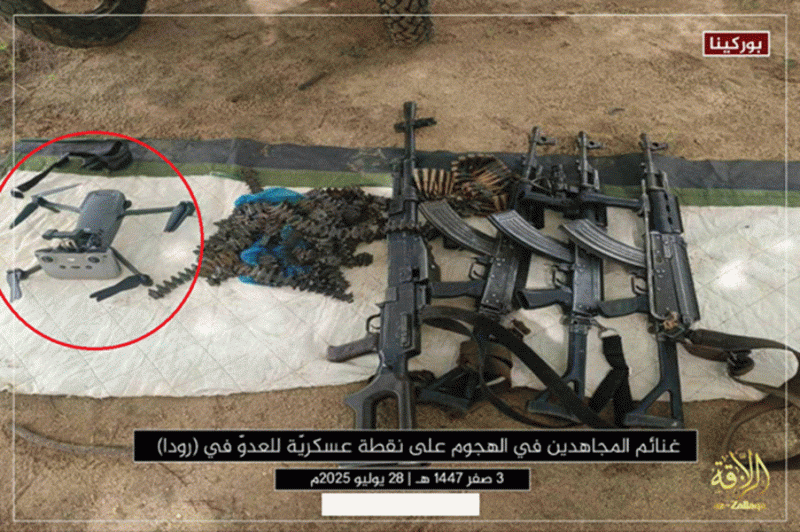
Example of a DJI drone belonging to Burkinabe forces and captured by JNIM in late July 2025.
The most significant military development in the Sahel is the introduction of fiber-optic UAVs, first used by the Azawad Liberation Front (FLA) this July. Such “quadcopters” are immune to electronic warfare (EW) systems used to disrupt the signal that normally guides UAVs. This is particularly relevant given that Russia recently supplied Mali with military vehicles equipped with such defensive systems, specifically designed to counter radio-controlled one-way attack (OWA) drones. The absence of efficient border control measures, combined with the ability of transnational non-state armed groups to take advantage of already-established routes for arms trafficking, will likely increase drone proliferation in the region. This represents an additional counterterrorism challenge for national security forces and their international allies.

Image shared by pro-Azawad accounts showing a fiber optic multirotor drone.
July began with a coordinated, large-scale, multi-front terrorist operation in Mali. In the early hours of July 1, hundreds of JNIM fighters launched simultaneous attacks on seven towns and three industrial sites across the Kayes and Ségou regions, spreading chaos among civilians, allegedly killing dozens of soldiers, destroying more than 100 military vehicles and motorbikes, and seizing 50 Kalashnikovs, 5 RPGs, 9 PIKAs, 60 mortars, 93 ammunition boxes, and other miscellaneous military equipment. They were eventually repelled by the Malian Armed Forces (Forces Armées Maliennes, FAMa), which were alerted promptly by the local populace.

Some of the spoils captured by JNIM on July 1st 2025.
Although the operation can hardly be deemed a success, given that the group lost more than 80 members in addition to vehicles and military gear, it represents a significant turning point from both a tactical and a strategic perspective. First, JNIM demonstrated a new level of operational sophistication by efficiently coordinating military operations spanning hundreds of kilometers. Second, this attack emphasized again JNIM’s determination to expand its activities in Central and Western Mali, an area previously spared from widespread and generalized non-state violence. Finally, the attack also showcased that JNIM is confident about its capabilities and is significantly better armed than in the past. Nevertheless, these attacks show that the group lacks the ability to seize strategic centers such as Kayes and Nioro.
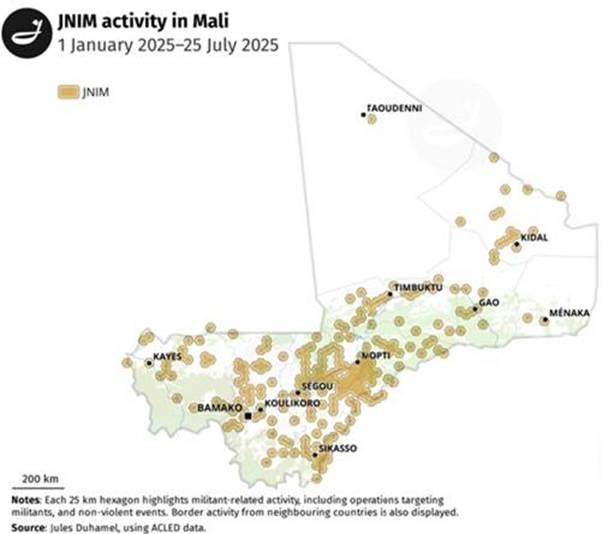
https://www.julesduhamel.com/mali-map-of-jnim-activity-january-july-2025/
Finally, the attack on Kayes and industrial centers (in which foreign workers were kidnapped) represents an additional warning for Bamako, going beyond JNIM’s strategic objectives of weakening state authority and expanding its geographical reach. Kayes is Mali’s main supply route, a key hub both for commerce with Senegal and for gold mining activities. JNIM’s leadership clearly understands the area’s economic importance, and on July 2 it announced it would blockade both Nioro du Sahel and Kayes in response to the local population’s support for the armed forces. Following this announcement by JNIM, Senegalese authorities called on citizens to avoid traveling to Mali until the situation is resolved. This demonstrates that the threat is expanding and presents growing challenges not only for decision-makers in Bamako but also for those in Dakar and Nouakchott.
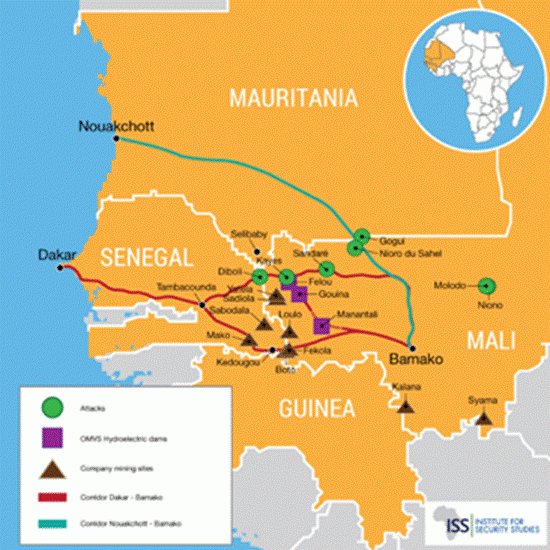
To effectively counter this escalating threat, Senegal, Mauritania and Mali should strengthen and broaden the scope of the cross-border cooperation mechanism established in 2007, prioritizing military responsiveness, intelligence sharing, and developing measures to efficiently patrol the shared borders.
During much of July, JNIM maintained a lower profile in Burkina Faso, focusing on small, targeted operations against both the armed forces and the Volunteers for the Defense of the Homeland (VDPs). The sole exception to this trend was a July 28 attack on a military post in Dargo, which claimed the lives of around 50 soldiers.
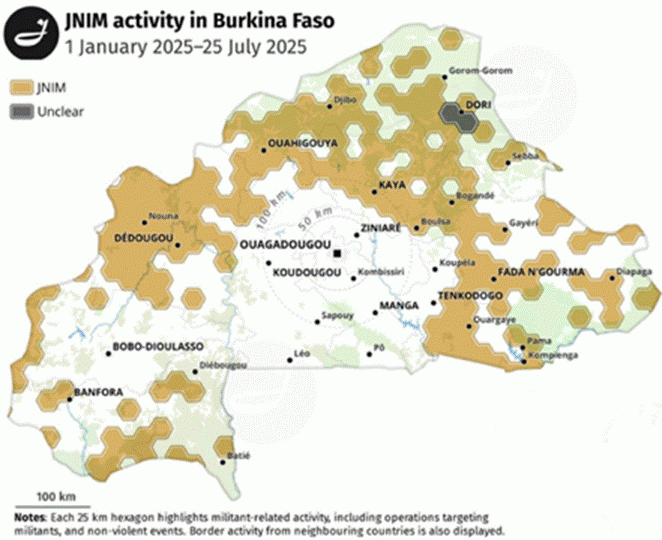
https://www.julesduhamel.com/burkina-faso-map-of-jnim-activity-january-july-2025/
However, this reduced activity does not signal a weakening of the group’s control over the country. Despite the number of reported violent events having plateaued between 2023 and 2024, Burkina Faso still accounts for the vast majority of the nearly 10.700 casualties of terrorist attacks in the Sahel (see the following graph), while the government now controls only 40 percent of the country’s territory.
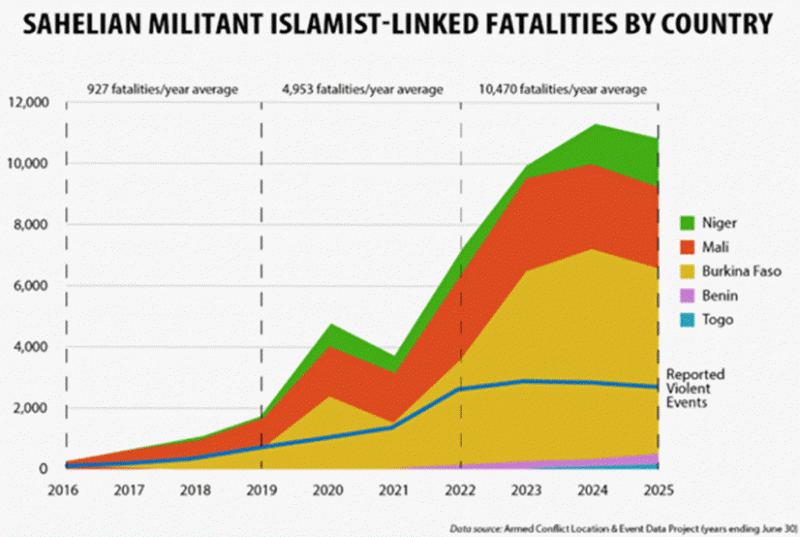
Africa Surpasses 150,000 Deaths Linked to Militant Islamist Groups in Past Decade
(https://africacenter.org/spotlight/en-2025-mig-10-year/)
Ouagadougou’s primary challenge is the progressive evolution of JNIM’s role and its consequent entrenchment throughout the country. In addition to seizing ghanima (loot) from attacks on military bases and outposts, this terrorist group has increasingly integrated into the region’s illicit economies by exploiting fuel and arms smuggling routes in the tri-border area between Côte d’Ivoire, Burkina Faso, and Ghana (see map below). JNIM was also able to co-opt armed bandits in the South to profit from lucrative cattle rustling, as livestock production constitutes to 11 percent of the country’s annual GDP.
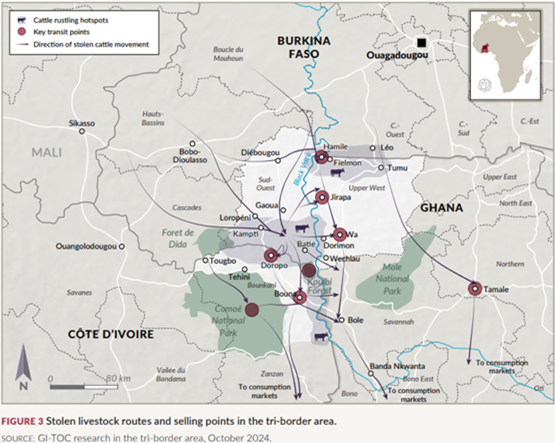
In Niger, JNIM’s terrorist activities have been limited to the Southwest regions of Dosso and Tillabéri. However, the United Nations Analytical Support and Sanctions Monitoring Team’s July 2025 report indicates that JNIM’s primary objective is to prevent ISSP “from establishing a foothold stretching from Burkina Faso to Benin.”
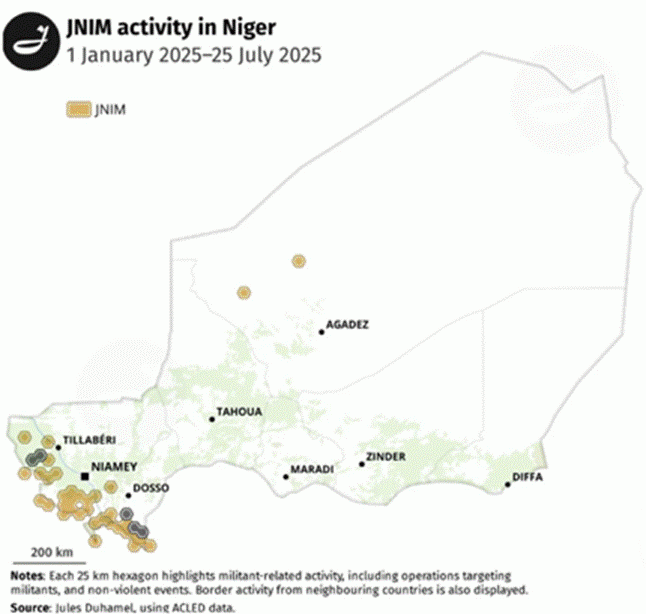
https://www.julesduhamel.com/niger-map-of-jnim-activity-january-july-2025/
The authorities of Burkina Faso, Mali, and Niger are not completely idle in the face of these multiple threats. In late June, the Malian government, with the support from Russian mercenaries that are part of the Africa Corps, was able to neutralize an high profile ISSP target named Souleymane Ag Bakawa. He was one of the leaders of the Islamic State offshoot in the Ménaka region. Similarly, Burkina Faso’s national armed forces have conducted successful operations against jihadist groups, such as the recent joint Nigerien-Burkinabe counter-insurgency effort in the Ougarou area of the Est region.
However, these military operations are not decisive enough to address the underlying causes of local and regional instability. The security forces of the three military juntas in Western Sahel have increasingly resorted to indiscriminate violence against civilians. Such widespread arbitrary violence excacerbates local grievances and pushes marginalized communities to sympathize for and join the ranks of terrorist organizations. A recent Human Rights Watch report, for instance, highlights this dynamic in Mali, stating that during the first seven months of 2025 the military junta “and the allied Russia-backed Wagner Group [later replaced by the Africa Corps] have committed dozens of summary executions and enforced disappearances of ethnic Fulani men . . . whom they accuse of collaborating with the JNIM.”
Consequently, the Sahel region remains the “global epicenter of terrorism deaths” as terrorist groups keep expanding their presence. This cross-border phenomenon carries significant security repercussions for the United States and the European Union.
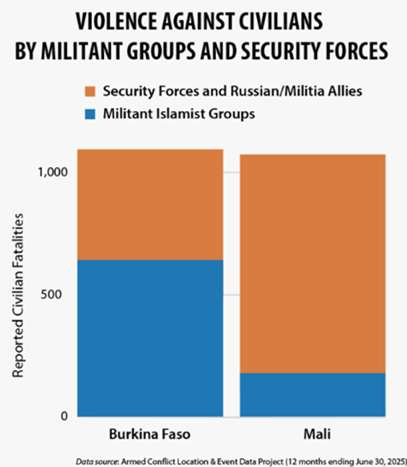
https://africacenter.org/spotlight/en-2025-mig-10-year/
As JNIM’s operational capabilities and resources grow, it could transition from being a terrorist organization enforcing its ideology and adherence to its interpretation of Islam into a political entity governing the territories it controls. After all, the group has already shown signs of consolidating its influence, engaging more deeply with local communities and collecting zakat (taxes) in exchange for security guarantees in areas where national authorities have lost control. Further demonstrating this shift, JNIM issued a 2-page statement on July 26 criticizing the juntas because “the Sahel governments continue their criminal path against the peoples of the region, as their armies continue to kill innocents and massacre women, children, and the elderly . . . and confiscate money and property through brutal massacres and barbaric practices, under Russian support and care”. By portraying itself as a protector of civilians, JNIM seeks to gain legitimacy and broaden its support, especially among ethnic groups that face harassment and violence from national security forces and their allies.
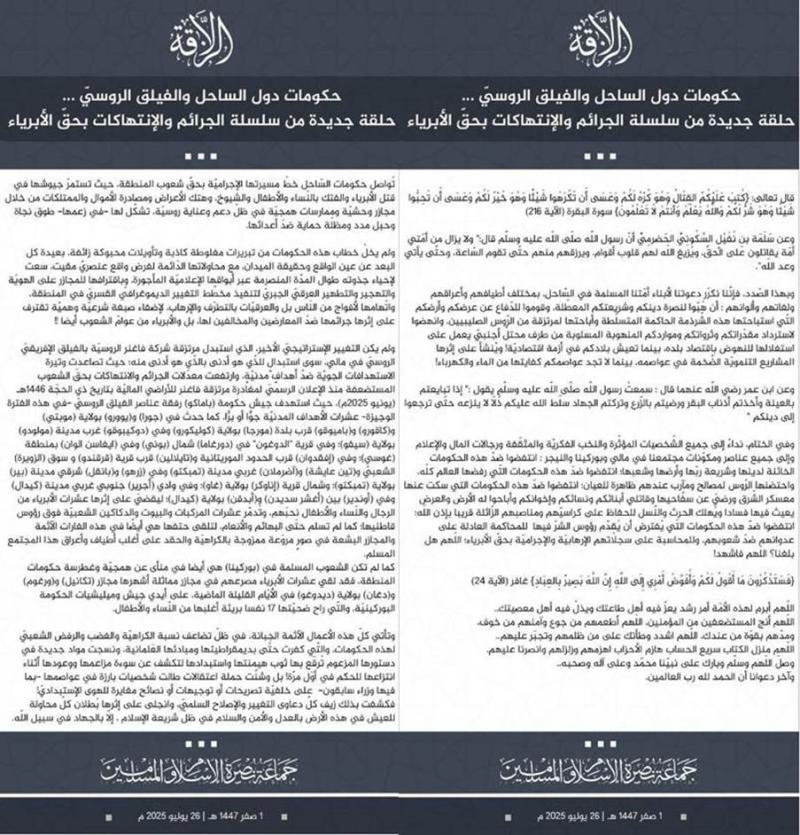
JNIM statement condemning the military juntas in the Sahel.
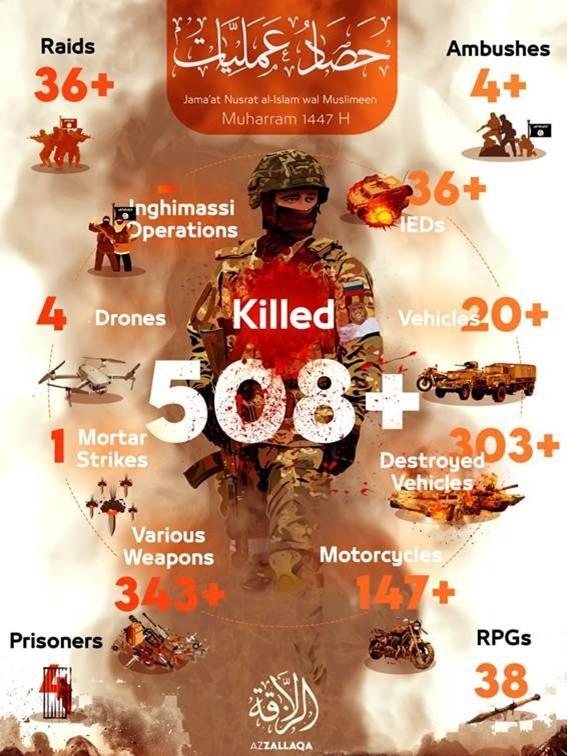
ISSP (5 claims)
The Sahelian branch of the Islamic State showed limited activity throughout July, carrying out only 5 attacks. However, the group continued implementing its two-pronged strategy—undermining JNIM’s entrenchment while continuing to storm military barracks and ambush the various national armies. While a few attacks occurred in Niger and Mali, Burkina Faso emerged as the primary battleground for the ISSP in July. On July 22, the group reported clashes with JNIM fighters in Dori, a small department in eastern Burkina Faso near the border with Niger. This confrontation led to the death of at least 5 terrorists. The largest ISSP attack on government forces occurred six days later, on July 28, when the ISSP was able to take a Burkinabe Army convoy by surprise. This attack left more than 30 troops dead, while ISSP seized weapons, vehicles, and ammunition.
As reported in the above-mentioned U.N. Analytical Support and Sanctions Monitoring Team report,
[ISSP] remained confined to a relatively limited zone, but appeared intent on extending its reach, especially within the Niger. The threat it posed remained localized. Isolated and lacking the means to project force outside the region, aside from nationals present in the Sahel, it remained focused on survival.
However, ISSP is attempting both to bolster its financial resources by resorting to “kidnappings, either directly or through local criminal networks” and to establish stronger roots, especially in “a sanctuary north of Niamey,” pushing to penetrate progressively into Northwestern Nigeria through the Lakurawa group, as this could “broaden its recruitment base.”
ISWAP (14 claims)
ISWAP released a total of 14 claims in the month of July—12 related to Nigeria and 2 to Cameroon—a noticeable decrease from June’s figure. This can be attributed to the beginning of the rainy season, which impedes insurgent movements, and also to the “Burn the Camps”
campaign (see below) nearing its end, as the terrorists regroup, replan, and recuperate following high-intensity activities in recent months.
ISWAP still conducted a few high-impact attacks against the Nigerian army during July, including the attack on the Mallam Fatori military barracks on July 3, which killed and wounded an unspecified number of soldiers. Interestingly, one of the primary targets of the attack was excavators, recently brought in to improve the trenches that protect the resettled community and army positions. ISWAP claimed that it destroyed five of those excavators during the attack.
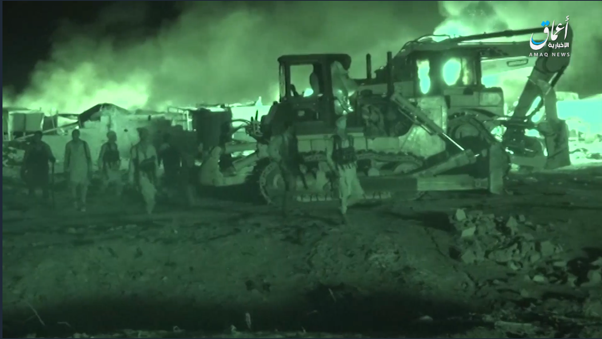
Amaq video showing the destruction of the excavators in Mallam Fatori, July 3.
Bitta was the second Nigerian camp attacked in July. On the night of July 22, an ISWAP cameraman was killed and his camera and weapon were recovered. Nevertheless, the group still managed to post an image from inside of the camp, showing an artillery piece on fire.
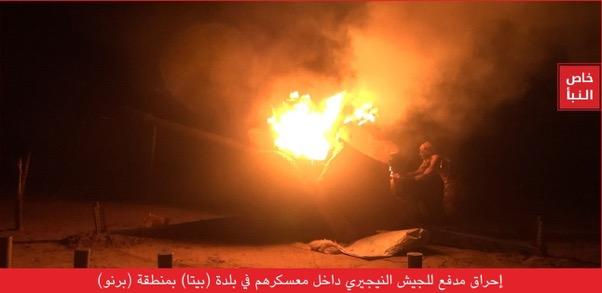
Image from ISIS newspaper an-Naba, showing an ISWAP terrorist setting an artillery piece ablaze in the Bitta military camp.
On July 4, ISIS’s Amaq Agency released an infographic detailing operations of its affiliates in the first half of 2025. According to this graphic, the operations of ISWAP during the first half of 2025 included:
In Cameroon: 76 killed and wounded in 18 attacks.
In Nigeria: 734 killed and wounded in 215 attacks.
In Niger (this includes ISSP): 233 killed and wounded in 21 attacks.
These figures represent claimed casualties of soldiers and militiamen loyal to the respective countries, and, in rare cases, killed Christians.
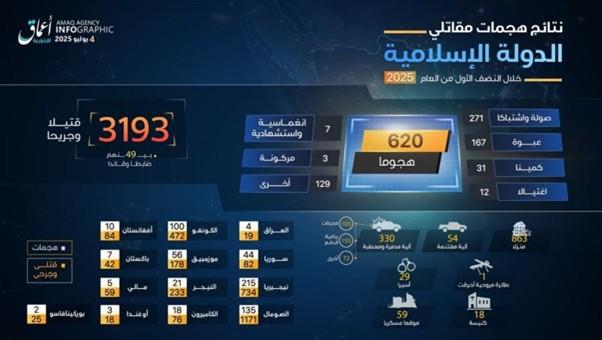
Infographic released by Amaq Agency on July 4th.
On July 10, ISIS released a second infographic detailing the results of the “Burn the Camps” campaign over the past four months, from March 6 to July 3. The release notably included Mozambique and the Democratic Republic of Congo (DRC), confirming that the campaign has expanded to Islamic State Central Africa Province (ISCAP) and the Islamic State Mozambique Province (ISMP) alongside ISWAP and ISSP.
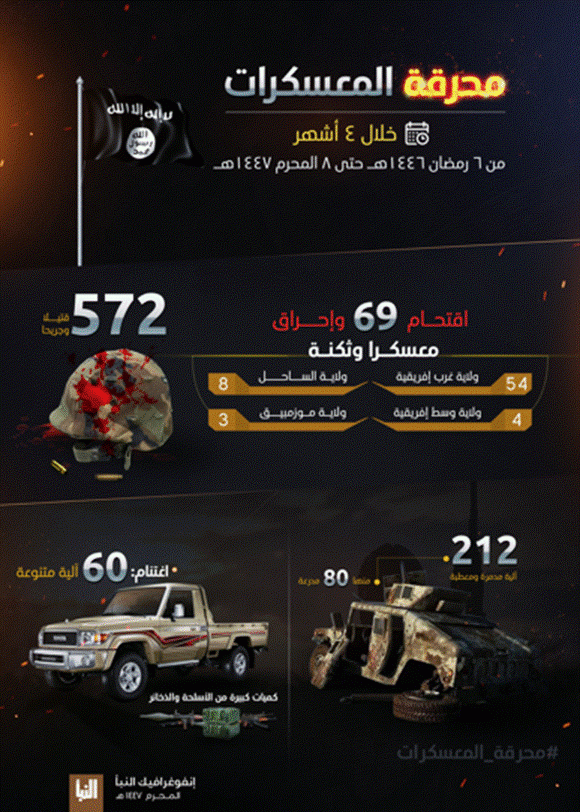
Infographic released by ISIS through an-Naba, July 10th.
According to these figures, ISWAP remains the most active affiliate, striking 54 camps and barracks, followed by ISSP with 8, ISCAP with 4, and ISMP with 3. The Islamic State claims that a total of 572 soldiers and militiamen were killed or wounded, along with 60 vehicles captured and 212 destroyed, including 80 armored vehicles. Unlike JNIM’s more detailed data, this infographic does not list weapons that were captured.
Vehicle losses alone have cost the Nigerian military millions of dollars. Both valuable main battle tanks (MBTs) and several mine-resistant ambush protected vehicles (MRAPs) were among the destroyed equipment. These material losses worsen the human toll and reduce military morale.
ISWAP also seems to have adjusted its primary propaganda narrative from focusing on highlighting the army as the main adversary to spotlighting the punishment of traitors and spies within its own network. On July 17th, ISWAP announced in an-Naba that a video would soon be released on the “Consequences of Treason.” The next day, the video was released, featuring interviews in Kanuri of local chiefs, army informants, and the regional Civilian Joint Task Force (CJTF) members who were captured by the group.
After the interviews and confessions, the prisoners were executed. This mirrored ISIS’s propaganda imagery from Syria and Iraq.
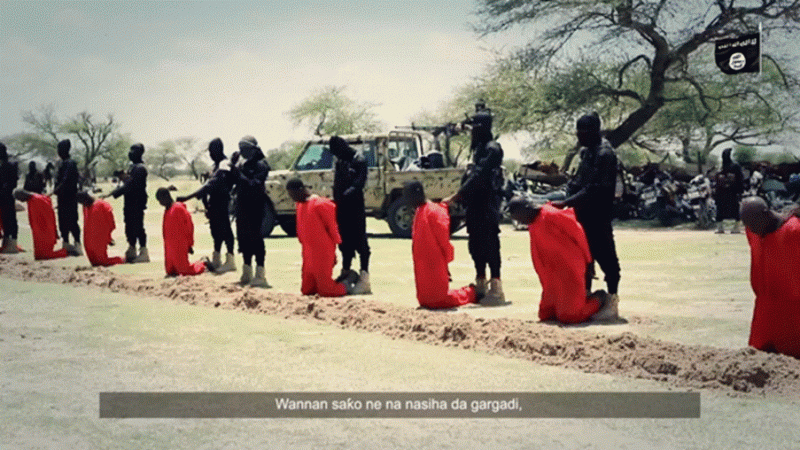
Screenshot from ‘The Consequences of Treason’.
Given the video, one can infer that the Nigerian army and the CJTF have intensified their attempts to infiltrate the ISWAP network. This is clearly a reaction to ISWAP attempts to infiltrate their ranks. How successful these efforts were remains unclear. Obviously, filming these executions was also intended to intimidate the local population and deter them from supporting the military and the CJTF.
In Cameroon, security forces achieved a significant victory over ISWAP by repelling an attack on the night between July 2 and 3 in Filma. This is mostly due to the effective intervention of the Brigade d’Intervention Rapide (BIR), nicknamed the “Israeli Unit” due to its Israeli weapons and training. This elite unit of the Cameroonian army is active in the north of the country. ISWAP lost at least 9 fighters and an unknown number were wounded. Interestingly, the group did not refer to this attack in its public messaging.
ISWAP claimed 2 attacks in Cameroon: One in Zigue, which did not resulted in casualties as the soldiers had already withdrawn to the interior, and another one in Gouloudjahan, killing a soldier. During both attacks, military equipment was captured by the terrorists.
A concerning phenomenon has been taking place in Cameroon. Following the “Burn the Camps” offensive, the Cameroonian army has begun withdrawing from several positions, leaving the bases empty of troops. This rewards ISWAP’s strategy of attritional warfare. As troops withdraw inland, ISWAP gains more freedom of movement and can begin entering new towns, from which they can collect taxes and in which they can leave representatives. At least three bases have effectively been vacated in Cameroon (Soueram, Sagme and Amchide) and one in Nigeria (Wulgo).
The two images below show a comparison of one of the military camps before and after the ISWAP attack on March 25, which killed at least 15 soldiers. The camp suffered another major attack on May 16, resulting in the death of one soldier. This second attack likely prompted the military to withdraw.
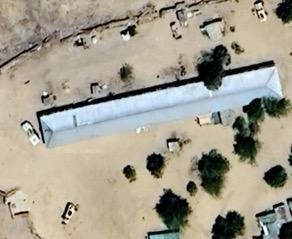

At the end of the month, on July 27, the Nigerian Air Force conducted airstrikes on an “ISWAP leadership cell” stationed in Arina Woje, on the shores of the Lake Chad. According to the army, the strikes resulted in devastating losses to ISWAP’s leadership, fighters, and logistics.
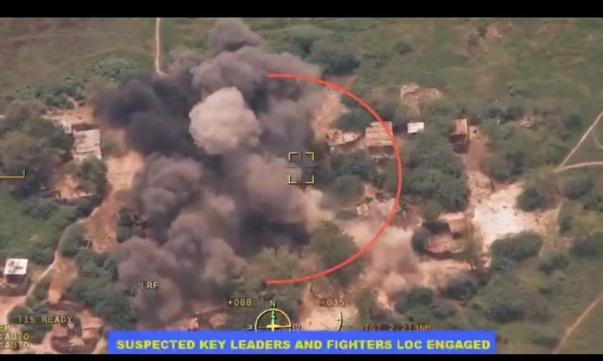
NAF airstrikes on an ISWAP leadership cell in Arina Woje, Borno state.
Summary
Overall in July, ISWAP activity slowed compared to previous months, with only 12 claimed attacks, largely due to the rainy season and the tapering off of the “Burn the Camps” campaign, However, the group still carried out notable strikes in Nigeria and Cameroon, while releasing propaganda to amplify its impact and intimidate local communities. The Nigerian Air Force inflicted possible losses on ISWAP leadership in Arina Woje, and Cameroonian forces, particularly the BIR, successfully repelled attacks. Nevertheless, the withdrawal of Cameroonian troops from several border bases has created space for ISWAP’s expansion. The group’s release of the “Consequences of Treason” video underscores both its reliance on fear to control populations and the likelihood of increased infiltration by state forces into its networks. Overall, ISWAP remains a persistent and adaptive threat, even amid a temporary operational slowdown.
Statistics

Total Number of Claims
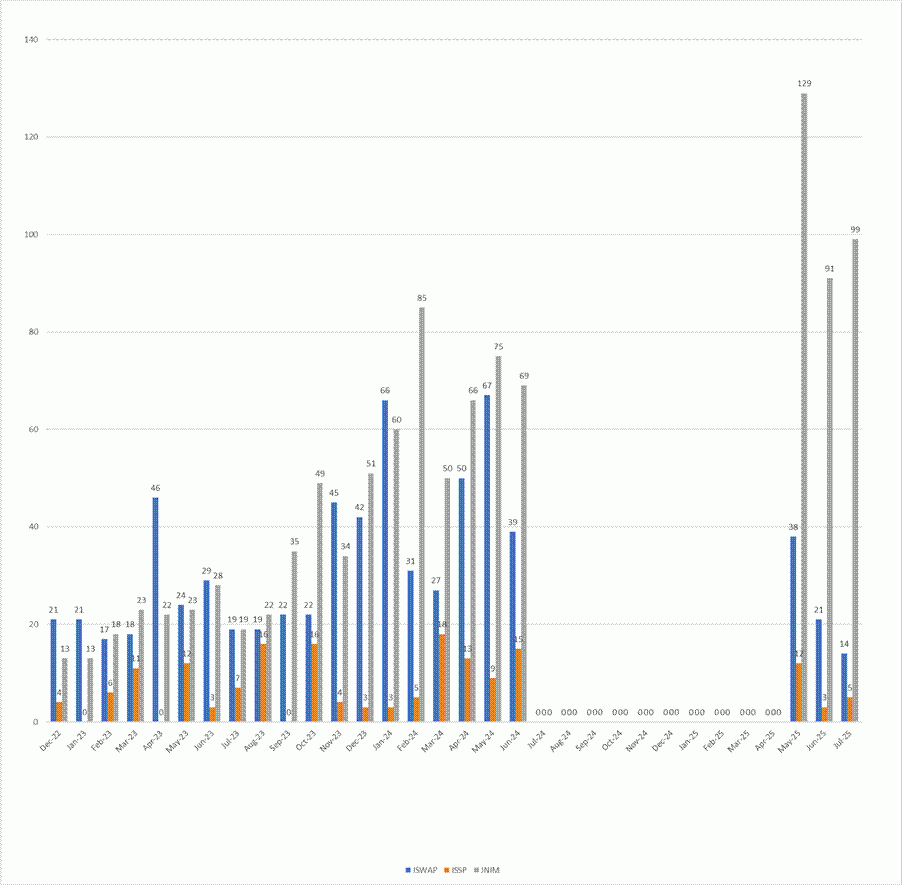
Claims per Group
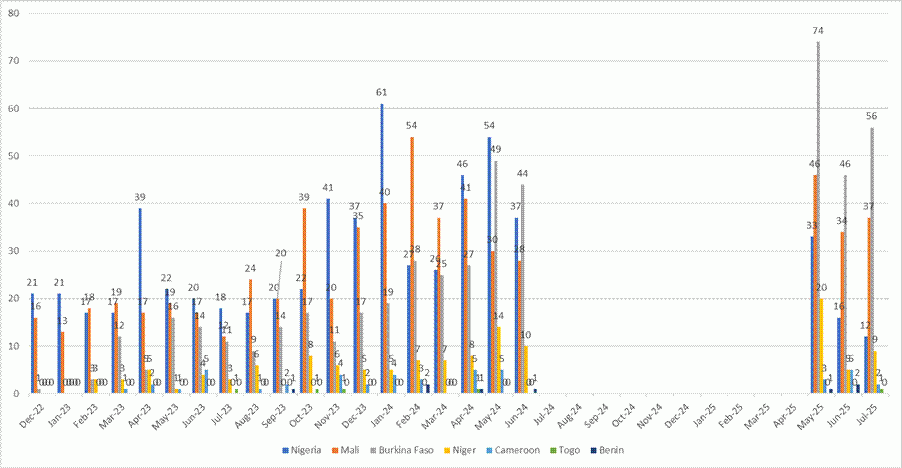
Claims per Country
Stay up to date on our latest news.
Get the latest news on extremism and counter-extremism delivered to your inbox.